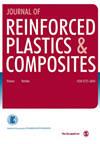横向荷载下三维打印缟玛瑙嵌套环能量吸收能力的实验研究
IF 2.2
3区 材料科学
Q3 MATERIALS SCIENCE, COMPOSITES
引用次数: 0
摘要
本研究对嵌套圆环在横向载荷作用下的能量吸收特性和破坏机制进行了重点实验探索。圆环采用熔融沉积建模法进行三维打印,材料为含有切碎碳纤维的缟玛瑙。圆环的宽度和厚度尺寸相同,直径则有四个不同值。嵌套环样品由至少两个、最多五个单独的环组成。这些样品是通过使用不同顺序和次序的单个环获得的。还对每种嵌套样品类型的两种不同配置进行了研究,以观察环的顺序和次序对能量吸收能力的影响。研究结果表明,尽管直径最小的单环具有最高的力值,但另一个单环却具有最高的能量吸收和比能量吸收值。单环的排列对嵌套样品的能量吸收能力有更好的影响。此外,由于单环之间的相互作用,在嵌套样品中也观察到了吸收能量的增加。这种相互作用表明,嵌套样品中使用的单环能量值的代数和低于相同嵌套样品的能量值。在嵌套样品中,吸收的能量与单环的数量成比例增加。然而,耐撞性参数受到的影响与能量吸收能力截然不同。虽然具有五个单环的嵌套样品的能量吸收值最高,但其他嵌套样品的某些耐撞性参数也达到了最高值。与包含四个单环和三个单环的相同嵌套样品组合相比,NR5-A 样品吸收的能量分别高出 52% 和 88%。此外,与上述相同的嵌套样品相比,该样品的比能量吸收值分别高出 32% 和 47%。考虑到这些结果,可以说 NR5-A 样品是理想的能量吸收结构的最佳设计。本文章由计算机程序翻译,如有差异,请以英文原文为准。
Experimental investigation on energy absorption capability of 3D printed onyx nested rings under lateral loading
This study presents a focused experimental exploration into the energy absorption characteristics and failure mechanisms of nested circular rings under lateral loading. The rings were 3D printed using the fuse deposition modeling method with an onyx material containing chopped carbon fiber. The dimensions of the rings were determined to be the same in width and thickness, while the diameter had four different values. The samples of nested rings consist of at least two and up to five individual rings. These samples were obtained by using individual rings in various different sequences and orders. Two different configurations for each nested sample type were also studied to observe the effect of the ring sequences and orders on the energy absorption capability. It is concluded from the results that even though the single ring with the smallest diameter has the highest force values, the highest energy absorption and specific energy absorption values were obtained in another single ring. The alignment of the single rings has a superior effect on the energy absorption capacity of the nested samples. Also, a gain in absorbed energy was observed in nested samples due to the interaction between the single rings. This interaction showed that the algebraic summation of the energy values of single rings used in a nested sample was lower than the energy value of the same nested sample. In the nested samples, the absorbed energy increased proportionally to the number of single rings. However, the crashworthiness parameters were affected quite differently from the energy absorption capacity. While the highest energy absorption values are obtained in nested samples with five single rings, other nested samples reached the highest values in terms of some of the crashworthiness parameters. The NR5-A sample absorbed 52% and 88% higher energy compared to the same combination of nested samples, which contain four and three single rings, respectively. Additionally, the specific energy absorption value of this sample is 32% and 47% higher than the same nested samples mentioned above. Considering these results, it can be expressed that the NR5-A sample is the best design in terms of an ideal energy absorption structure.
求助全文
通过发布文献求助,成功后即可免费获取论文全文。
去求助
来源期刊

Journal of Reinforced Plastics and Composites
工程技术-材料科学:复合
CiteScore
5.40
自引率
6.50%
发文量
82
审稿时长
1.3 months
期刊介绍:
The Journal of Reinforced Plastics and Composites is a fully peer-reviewed international journal that publishes original research and review articles on a broad range of today''s reinforced plastics and composites including areas in:
Constituent materials: matrix materials, reinforcements and coatings.
Properties and performance: The results of testing, predictive models, and in-service evaluation of a wide range of materials are published, providing the reader with extensive properties data for reference.
Analysis and design: Frequency reports on these subjects inform the reader of analytical techniques, design processes and the many design options available in materials composition.
Processing and fabrication: There is increased interest among materials engineers in cost-effective processing.
Applications: Reports on new materials R&D are often related to the service requirements of specific application areas, such as automotive, marine, construction and aviation.
Reports on special topics are regularly included such as recycling, environmental effects, novel materials, computer-aided design, predictive modelling, and "smart" composite materials.
"The articles in the Journal of Reinforced Plastics and Products are must reading for engineers in industry and for researchers working on leading edge problems" Professor Emeritus Stephen W Tsai National Sun Yat-sen University, Taiwan
This journal is a member of the Committee on Publication Ethics (COPE).
 求助内容:
求助内容: 应助结果提醒方式:
应助结果提醒方式:


